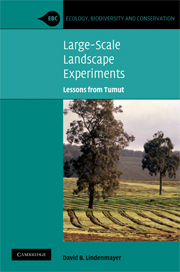Book contents
- Frontmatter
- Contents
- Preface
- Acknowledgements
- 1 The science of understanding landscape change: setting the scene for the Tumut Fragmentation Study
- 2 The theory: an overview of landscape change and habitat fragmentation
- 3 The field laboratory: the Tumut study area and the vertebrate animals it supports
- 4 Setting up the study: the design and implementation of the main cross-sectional study at Tumut
- 5 The core findings: the effects of landscape context on animals and plants
- 6 Patch use: how animals use patches of remnant eucalypt forest surrounded by pine
- 7 Theory against data: testing ecological theories and concepts
- 8 Testing PVA models with real data: melding demographic work with population modelling
- 9 Genes in the landscape: integrating genetic and demographic analyses
- 10 Refining and extending the research programme: additional studies at Tumut (and nearby) that build on the Fragmentation Study
- 11 Recommendations for plantation managers: implications for biodiversity and conservation in plantations
- 12 Lessons on running large-scale research studies: some insights from running the Tumut Fragmentation Study and directions for the future
- Appendix 1 List of collaborators/contributors to the Tumut Fragmentation Experiment
- Appendix 2 Detections of bird species in the Tumut Fragmentation Study classified by four broad classes of sites
- References
- Index
12 - Lessons on running large-scale research studies: some insights from running the Tumut Fragmentation Study and directions for the future
Published online by Cambridge University Press: 20 May 2010
- Frontmatter
- Contents
- Preface
- Acknowledgements
- 1 The science of understanding landscape change: setting the scene for the Tumut Fragmentation Study
- 2 The theory: an overview of landscape change and habitat fragmentation
- 3 The field laboratory: the Tumut study area and the vertebrate animals it supports
- 4 Setting up the study: the design and implementation of the main cross-sectional study at Tumut
- 5 The core findings: the effects of landscape context on animals and plants
- 6 Patch use: how animals use patches of remnant eucalypt forest surrounded by pine
- 7 Theory against data: testing ecological theories and concepts
- 8 Testing PVA models with real data: melding demographic work with population modelling
- 9 Genes in the landscape: integrating genetic and demographic analyses
- 10 Refining and extending the research programme: additional studies at Tumut (and nearby) that build on the Fragmentation Study
- 11 Recommendations for plantation managers: implications for biodiversity and conservation in plantations
- 12 Lessons on running large-scale research studies: some insights from running the Tumut Fragmentation Study and directions for the future
- Appendix 1 List of collaborators/contributors to the Tumut Fragmentation Experiment
- Appendix 2 Detections of bird species in the Tumut Fragmentation Study classified by four broad classes of sites
- References
- Index
Summary
Before bringing this book to a close it is worth reflecting on some of the major issues and challenges associated with maintaining a large-scale, long-term project like the Tumut Fragmentation Study. Of course, much work remains to be done and the last part of this chapter discusses some directions for future work.
The challenges of maintaining a large-scale, multifaceted research project
It's my hope that this book has highlighted the diverse and multifaceted nature of the research programme undertaken at Tumut. Most of my colleagues consider that the work at Tumut has been productive and useful, and has changed thinking in some areas of ecology as well as altering approaches to the management of plantations. However, the maintenance of the work undertaken over the past 12+ years has involved more than its fair share of challenges. Three of these are outlined below. They are briefly summarised to illustrate some of the hurdles that can arise and that might hopefully be avoided by others embarking on long-term, large-scale research studies.
Data curation and management
The maintenance of a high-quality dataset is a pivotal part of any successful long-term ecological project. This sounds like a trivial point to most scientists. But the reality is that the curation of data is often an afterthought in the vast majority of ecological projects. Indeed, I have personally witnessed many cases where government agencies have discarded high-quality datasets that were not long afterwards recognised as being extremely important.
- Type
- Chapter
- Information
- Large-Scale Landscape ExperimentsLessons from Tumut, pp. 235 - 240Publisher: Cambridge University PressPrint publication year: 2009

